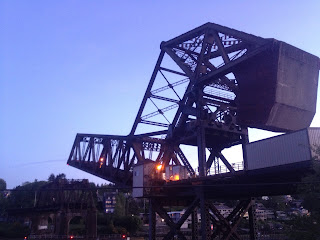BNSF Railroad Bridge Number 4.
This bridge is the first bridge to greet a mariner on the Lake Washington Ship Canal and is an offshoot of the bascule bridge type we have previously discussed. A Heel-Trunnion bridge, this name derives from the trunnion being located in the heel of the bridge, (If you consider the bridge to look like a large foot) often above the roadbed by a small amount. These Bridges are fascinating and at first glance a little difficult to understand, so let's break down the parts and pieces.
The bridge has 5 joints that pivot during the lift sequence. The drawspan will revolve around the trunnion as with a regular bascule bridge, but the counterweight has been moved away from the drawspan itself. The operating strut in this image would slide to the left, and pull on the top-left corner of the drawspan. The counterweight and its associated frame on top of the triangular base would rotate down and fold the bridge as seen below:
The heel trunnion design seems useful for a situation in which it is not desirable to construct a large below-grade counterweight pit, simply because the counterweight pit is eliminated from the design. This bridge and another over the Duwarmash River in Seattle are both railroad bridges and are in places where a large counterweight pit would be difficult to build. I wish I knew more about why this design is used in place of regular bascule bridges, since it seems like the underground counterweight is too little of an issue for a bridge. I'd bet this design is also more stable since the closed drawspan's trunnion is not a long distance away from the live-loads of traffic.
This bridge stands sentinel outside the Ballard Locks, or Hiram M. Chittenden Locks on the entrance to the Lake Washington Ship Canal. It is usually maintained in a partially open position, except when closed to allow trains to pass over it. I have seen for myself and spoken to a tugboat captain who regularly requires a full opening, where the drawspan is nearly vertical.
There is no good way to get close to the bridge for sightseeing purposes but the locks provide a decent vantage themselves, as does a bike path under the railroad line from which the first picture was taken.
Now that all three bridge-types have been introduced, the next post will focus on the next bridge in the Seattle Sequence; Ballard




















